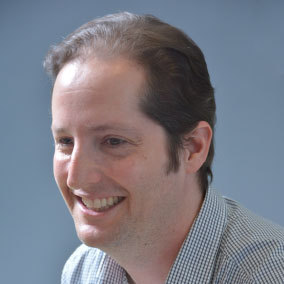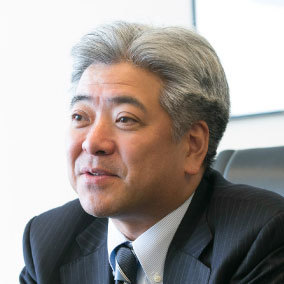A company can’t become a global market leader without succeeding in the Japanese market.
—Can you describe the sequence of events from your entry into the Japanese market to where you are today?

Danny Risberg
This year marks the 61st since Philips broke into the Japanese market. Through mergers led by the head office and tie-ups with other companies, we’ve stepped up efforts in re-invention (i.e., repetition of invention) and re-innovation (repetition of innovation). The Philip’s corporate culture tends to emerge fairly clearly when you trace your way back through our history. Our company policy is to build up a business step by step, with our sights set on the next generation.
Philips of the Netherlands and Matsushita Electric Industrial Co., Ltd. (currently Panasonic Corporation) formed a technical cooperation agreement in 1952, establishing Matsushita Electronics Co., Ltd. as a joint venture that produced and sold lighting equipment and electronic components. In the following year, Nihon Denshi Kaihatsu was established as a company wholly owned by Matsushita Electronics. This new company, which is the forerunner of Philips Electronics Japan, began imports and sales of Philips products in the Japanese market. That’s how Philips got its start in Japan.
Those 61 years featured many turning points. The one most closely associated with Japan is the compact disk (CD), developed jointly by Philips and Sony and released in 1982. Less famously, the compact audio cassette, or so-called “cassette tape”, was developed by Philips and introduced in 1963 for the first time in the world. From the late 1990s to the 2000s, our company focused on medical fields. In addition to developing medical devices, we expanded our business portfolio through various mergers and acquisitions. With the 2001 acquisition of the medical equipment division of Agilent Technologies, a US company that split from Hewlett-Packard and later became totally independent, as well as the 2008 acquisition of Respironics, we doubled the number of employees in Japan. Since 2013, Philips has advanced into consumer goods targeting women, including Nonfryer and beauty home electric appliances. Our company currently specializes in Healthcare, Lighting, and Consumer Lifestyle products.
—Compared to markets in other countries, what are some key characteristics of the Japanese market and Japanese consumers?
Japanese people are just amazingly detail-oriented. Their penchant for detail affects not just product quality, but how many color variations are offered and even how easy packages are to open.
For example, the Philips shaver models in certain colors are offered only in Japan, because they’re based on the company’s consumer research in Japan. Users in other countries don’t care even if it’s harder to open a package, as long as the product is good quality. In contrast, the Japanese people are incredibly fussy and demanding. But unless we address this Japanese tendency toward detail-orientation, our products, even if they’re bought, won’t satisfy Japanese customers. In other words, if we can produce goods that satisfy Japanese customers, we can satisfy people all around the world. Before introducing new products, we sometimes ask Japanese consumers for their opinions or perform product tests in Japan. If we succeed in the Japanese market, where high quality products are a must, we can succeed globally.
—What’s the positioning of Japan in the global market?
It’s positioned as a critically important market. Currently, you won’t become a global market leader unless you succeed in Japan. If you can achieve the quality Japanese people demand, your products will sell anywhere in the world. Whether it’s consumer goods or medical devices, there’s much to learn from observing how Japanese users use the products or what their needs are. There have been lots of examples where the behavior and demands of Japanese consumers have led to the development of new products that translate well to other markets. In particular, Japan has the fastest aging population in the world. If we can build a business model in the field of healthcare, I’m sure we can take that model and apply it to other markets without changing anything.
Philips divides the globe into 17 markets and places a great deal of emphasis on Japan, among others, as an independent market. Based on its market size alone, Japan is worthy of serious consideration and offers the promise of significant sales. Our whole company shares the corporate mission of promoting innovation on behalf of customers. To achieve this goal, it’s vitally important to grasp consumer needs in this country and provide the information globally to take into consideration in the early product developmental stages.
The importance of getting one step closer to the needs of Japanese people
—What do you especially keep in mind when engaging in business in Japan?
We take special care to introduce our products where there’s already a market and to take the time needed to grasp market needs.

Developing products from scratch to meet the detail-oriented needs of the Japanese people would entail enormous time and cost. So, we keep our product lineup as is and carry out detailed research on the needs of Japanese consumers. We release our products only after thoroughly developing the strategies needed to win acceptance in this market.
For example, the “Nonfryer,” an oil-free deep fryer released last year, was a product sold around the world but one specially configured for Japanese consumers. We developed it based on careful research over a one-year period to determine what recipes Japanese consumers prefer and how they use their fryers. Sushi is what people abroad think of when they think of Japanese food, but Japanese housewives rarely make sushi at home. [laughs] But people abroad don’t know about things like this.
Our Nonfryer is called Airfryer abroad. But in Japan, names featuring the terms non-alcohol or non-oil are appealing to consumers, so we changed the name to Nonfryer and released the product under that name. By focusing on its healthy, safety, and fun aspects, we managed to score a major hit. This shows how important it is to get one step closer to the needs and preferences of the Japanese people.
—How are decisions made between the head office and the Japanese branch?
All Philips offices worldwide share a process called the Philips Business System (PBS). We’re using this system to its fullest.
We call this Business Market Combination (BMC). Success in business requires meeting both management demands and market needs. Based on constant dialogue, those in charge of the market in each country set their own goals and clarify where responsibility lies. The important thing here is that decisions need to be made from a vantage point from which market needs can be closely monitored. That’s because even though the system is applied in the same way in each country in terms of management decision-making and the product development process, each market has different needs. That’s why we maintain this close dialogue with each other at various levels, while we strive to eliminate waste, and to achieve effective management that minimizes unnecessary time and cost.
For example, individuals in charge of a certain business operation or product share information on customer needs and business operations through discussions and tell the head office what they need, such as “This product needs to be improved,” “This product is used in such and such a way in this country,” and so on. This system also works well for basic research. In one case, we created a hit product by applying technology developed for the Soymilk Maker launched in China in the middle of a soymilk boom to the Soup Maker sold in France.
If there’s a relationship of trust inside the company, discussions naturally become forward-looking. Minor mistakes made in the early stages are easily corrected through discussions. I want to continue enjoying my work and my sense of pride in working with the 1,700 employees at Philips Japan.
- Profile
- Danny Risberg Chief Executive Officer (CEO) of Philips Electronics Japan, Ltd.
Chief Executive Officer (CEO) of Philips Respironics GK. Mr. Risberg joined Respironics (currently Philips Respironics) in 1999. He has held various management positions, including VP Asia Pacific Sales & Marketing and VP International & CEO. In 2005, he became President and CEO of Fuji Respironics. In May 2009, he was named COO of Healthcare, Philips Electronics Japan, Ltd. In January, 2010, he assumed his present post. He is also Commissioner of Japan Medical Imaging and Radiological Systems Industries Association (JIRA) and Chairman of the European Business Council in Japan (EBC).


